Database Management System: Research Analysis, Implementation Strategy
VerifiedAdded on 2023/04/23
|10
|2182
|219
Report
AI Summary
This research report provides an analysis of Database Management Systems (DBMS), focusing on selecting the appropriate database for optimal decision-making and outlining the principles and strategies for effective implementation. It employs a design science research methodology (DSRM) to address business issues through innovative solutions, particularly in designing authoritative data frameworks. The report explores key research questions regarding database selection, implementation principles, and user interface design, advocating for SQL Server due to its reliability and scalability. The research also delves into data modeling strategies, data quality protocols, and security measures, emphasizing a multi-layered approach to database security. Ultimately, the report concludes that the sustainability of a DBMS depends on its alignment with specific requirements and attributes, highlighting the importance of appropriate systems and standardization in the design phase. The research also acknowledges the evolving landscape of data delivery and the need for continuous improvement in data quality management.
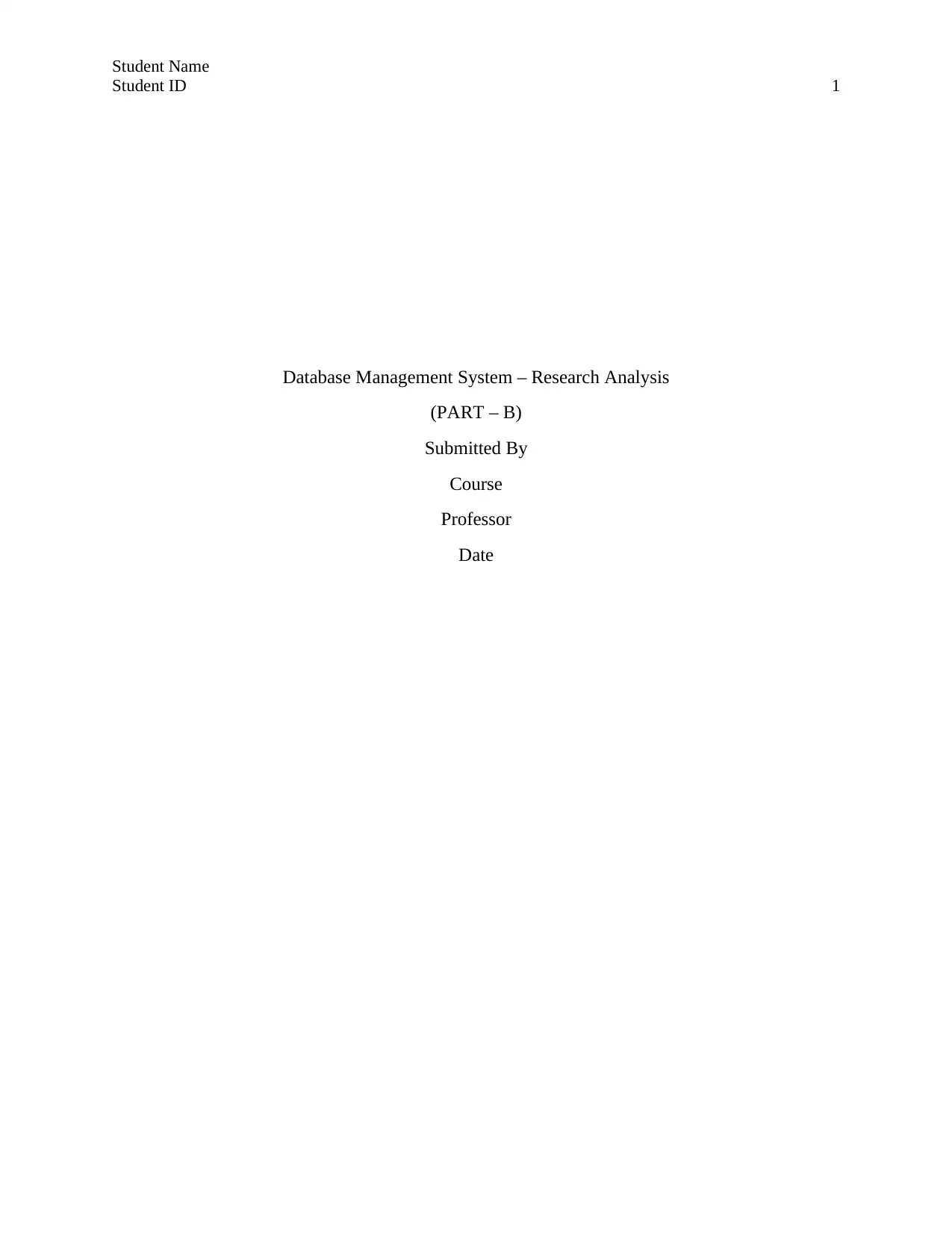
Student Name
Student ID 1
Database Management System – Research Analysis
(PART – B)
Submitted By
Course
Professor
Date
Student ID 1
Database Management System – Research Analysis
(PART – B)
Submitted By
Course
Professor
Date
Paraphrase This Document
Need a fresh take? Get an instant paraphrase of this document with our AI Paraphraser
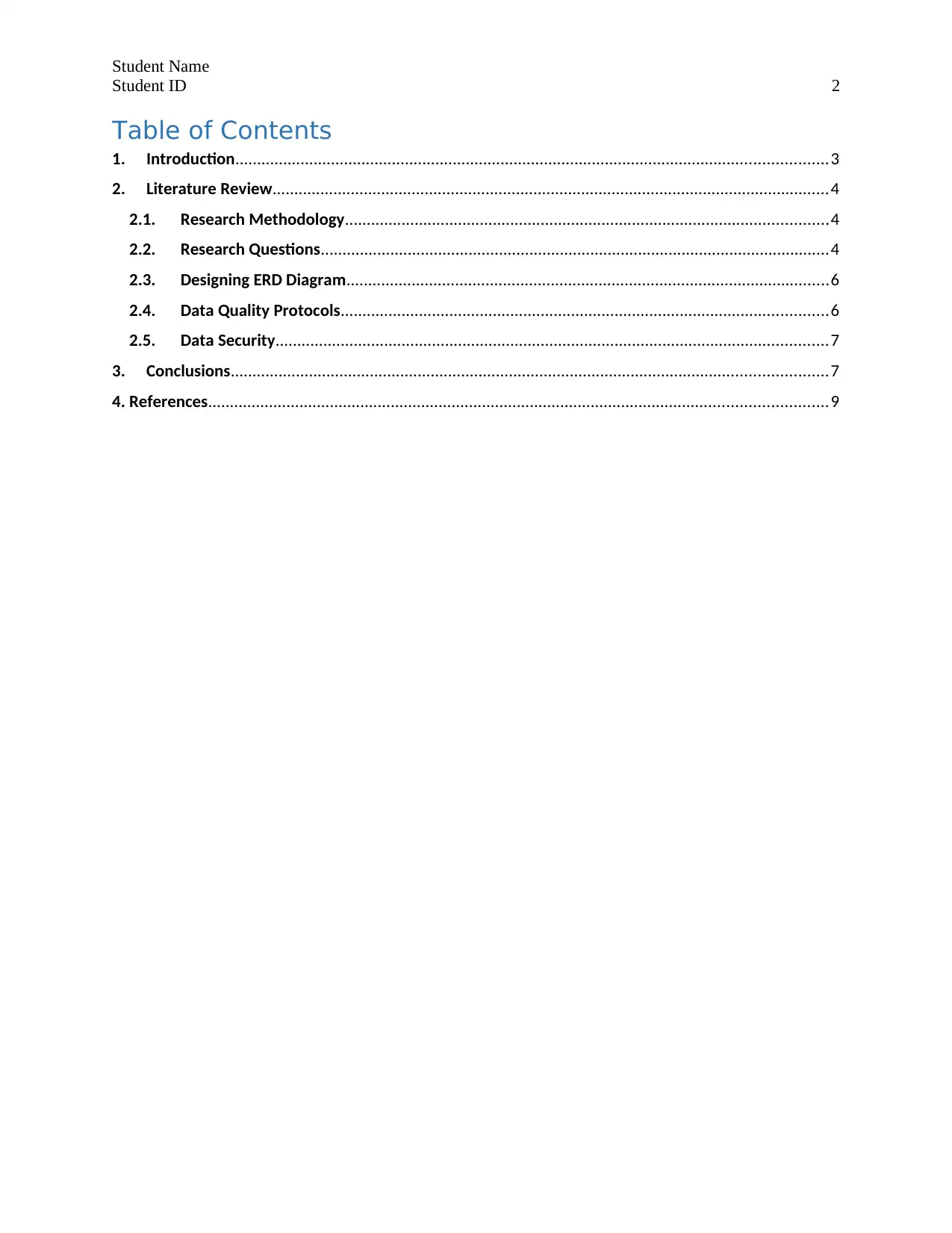
Student Name
Student ID 2
Table of Contents
1. Introduction........................................................................................................................................3
2. Literature Review................................................................................................................................4
2.1. Research Methodology...............................................................................................................4
2.2. Research Questions.....................................................................................................................4
2.3. Designing ERD Diagram...............................................................................................................6
2.4. Data Quality Protocols................................................................................................................6
2.5. Data Security...............................................................................................................................7
3. Conclusions.........................................................................................................................................7
4. References..............................................................................................................................................9
Student ID 2
Table of Contents
1. Introduction........................................................................................................................................3
2. Literature Review................................................................................................................................4
2.1. Research Methodology...............................................................................................................4
2.2. Research Questions.....................................................................................................................4
2.3. Designing ERD Diagram...............................................................................................................6
2.4. Data Quality Protocols................................................................................................................6
2.5. Data Security...............................................................................................................................7
3. Conclusions.........................................................................................................................................7
4. References..............................................................................................................................................9
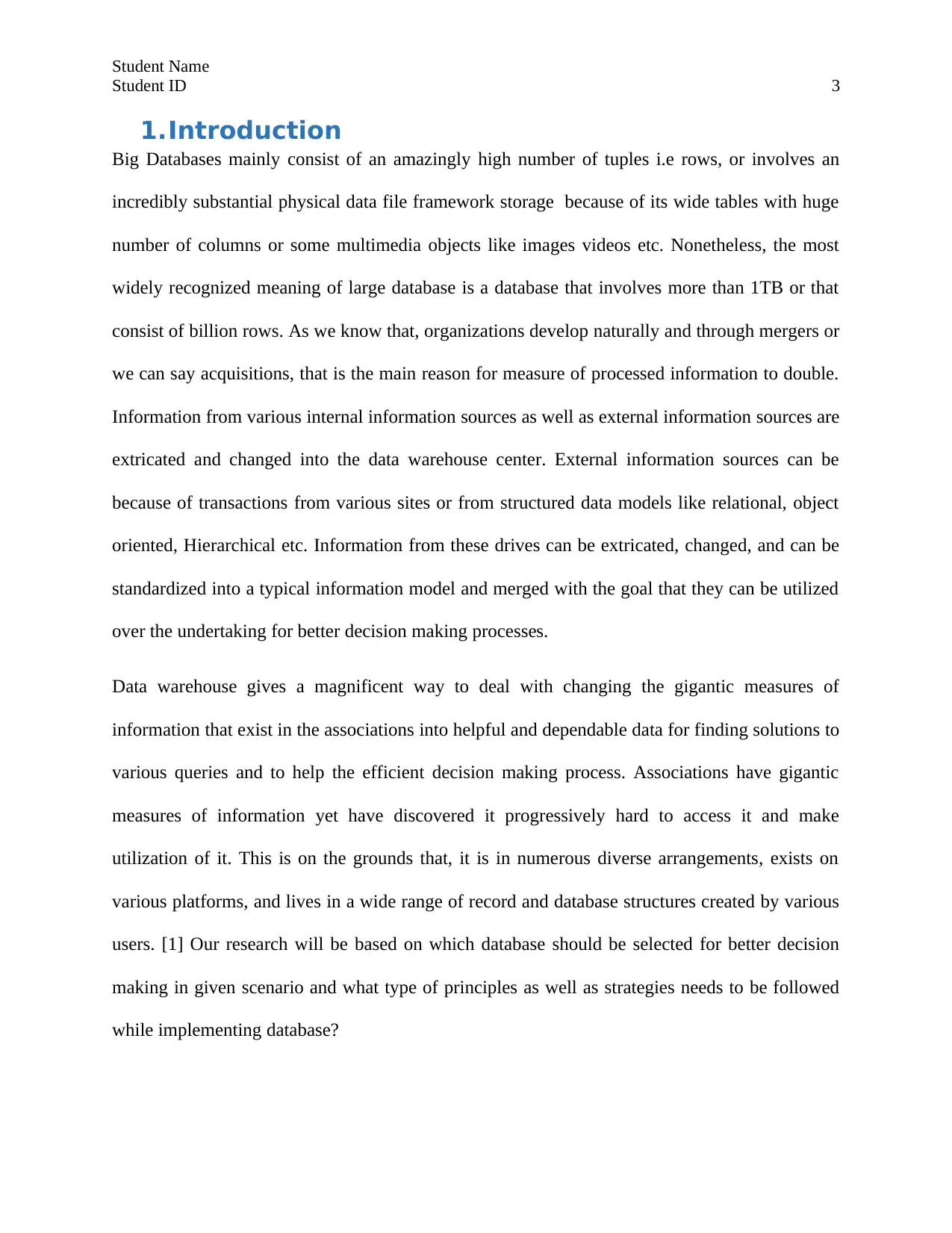
Student Name
Student ID 3
1.Introduction
Big Databases mainly consist of an amazingly high number of tuples i.e rows, or involves an
incredibly substantial physical data file framework storage because of its wide tables with huge
number of columns or some multimedia objects like images videos etc. Nonetheless, the most
widely recognized meaning of large database is a database that involves more than 1TB or that
consist of billion rows. As we know that, organizations develop naturally and through mergers or
we can say acquisitions, that is the main reason for measure of processed information to double.
Information from various internal information sources as well as external information sources are
extricated and changed into the data warehouse center. External information sources can be
because of transactions from various sites or from structured data models like relational, object
oriented, Hierarchical etc. Information from these drives can be extricated, changed, and can be
standardized into a typical information model and merged with the goal that they can be utilized
over the undertaking for better decision making processes.
Data warehouse gives a magnificent way to deal with changing the gigantic measures of
information that exist in the associations into helpful and dependable data for finding solutions to
various queries and to help the efficient decision making process. Associations have gigantic
measures of information yet have discovered it progressively hard to access it and make
utilization of it. This is on the grounds that, it is in numerous diverse arrangements, exists on
various platforms, and lives in a wide range of record and database structures created by various
users. [1] Our research will be based on which database should be selected for better decision
making in given scenario and what type of principles as well as strategies needs to be followed
while implementing database?
Student ID 3
1.Introduction
Big Databases mainly consist of an amazingly high number of tuples i.e rows, or involves an
incredibly substantial physical data file framework storage because of its wide tables with huge
number of columns or some multimedia objects like images videos etc. Nonetheless, the most
widely recognized meaning of large database is a database that involves more than 1TB or that
consist of billion rows. As we know that, organizations develop naturally and through mergers or
we can say acquisitions, that is the main reason for measure of processed information to double.
Information from various internal information sources as well as external information sources are
extricated and changed into the data warehouse center. External information sources can be
because of transactions from various sites or from structured data models like relational, object
oriented, Hierarchical etc. Information from these drives can be extricated, changed, and can be
standardized into a typical information model and merged with the goal that they can be utilized
over the undertaking for better decision making processes.
Data warehouse gives a magnificent way to deal with changing the gigantic measures of
information that exist in the associations into helpful and dependable data for finding solutions to
various queries and to help the efficient decision making process. Associations have gigantic
measures of information yet have discovered it progressively hard to access it and make
utilization of it. This is on the grounds that, it is in numerous diverse arrangements, exists on
various platforms, and lives in a wide range of record and database structures created by various
users. [1] Our research will be based on which database should be selected for better decision
making in given scenario and what type of principles as well as strategies needs to be followed
while implementing database?
⊘ This is a preview!⊘
Do you want full access?
Subscribe today to unlock all pages.

Trusted by 1+ million students worldwide
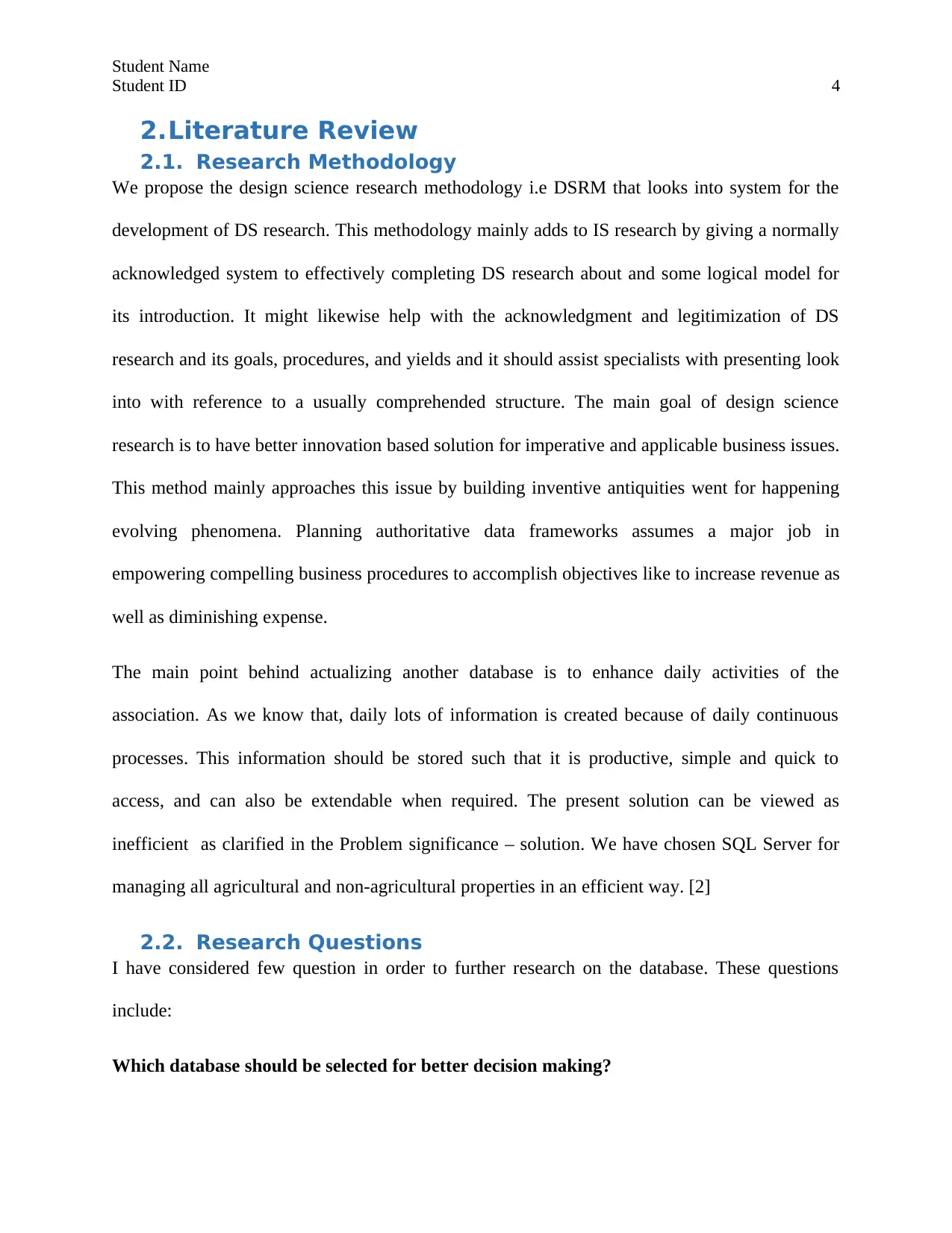
Student Name
Student ID 4
2.Literature Review
2.1. Research Methodology
We propose the design science research methodology i.e DSRM that looks into system for the
development of DS research. This methodology mainly adds to IS research by giving a normally
acknowledged system to effectively completing DS research about and some logical model for
its introduction. It might likewise help with the acknowledgment and legitimization of DS
research and its goals, procedures, and yields and it should assist specialists with presenting look
into with reference to a usually comprehended structure. The main goal of design science
research is to have better innovation based solution for imperative and applicable business issues.
This method mainly approaches this issue by building inventive antiquities went for happening
evolving phenomena. Planning authoritative data frameworks assumes a major job in
empowering compelling business procedures to accomplish objectives like to increase revenue as
well as diminishing expense.
The main point behind actualizing another database is to enhance daily activities of the
association. As we know that, daily lots of information is created because of daily continuous
processes. This information should be stored such that it is productive, simple and quick to
access, and can also be extendable when required. The present solution can be viewed as
inefficient as clarified in the Problem significance – solution. We have chosen SQL Server for
managing all agricultural and non-agricultural properties in an efficient way. [2]
2.2. Research Questions
I have considered few question in order to further research on the database. These questions
include:
Which database should be selected for better decision making?
Student ID 4
2.Literature Review
2.1. Research Methodology
We propose the design science research methodology i.e DSRM that looks into system for the
development of DS research. This methodology mainly adds to IS research by giving a normally
acknowledged system to effectively completing DS research about and some logical model for
its introduction. It might likewise help with the acknowledgment and legitimization of DS
research and its goals, procedures, and yields and it should assist specialists with presenting look
into with reference to a usually comprehended structure. The main goal of design science
research is to have better innovation based solution for imperative and applicable business issues.
This method mainly approaches this issue by building inventive antiquities went for happening
evolving phenomena. Planning authoritative data frameworks assumes a major job in
empowering compelling business procedures to accomplish objectives like to increase revenue as
well as diminishing expense.
The main point behind actualizing another database is to enhance daily activities of the
association. As we know that, daily lots of information is created because of daily continuous
processes. This information should be stored such that it is productive, simple and quick to
access, and can also be extendable when required. The present solution can be viewed as
inefficient as clarified in the Problem significance – solution. We have chosen SQL Server for
managing all agricultural and non-agricultural properties in an efficient way. [2]
2.2. Research Questions
I have considered few question in order to further research on the database. These questions
include:
Which database should be selected for better decision making?
Paraphrase This Document
Need a fresh take? Get an instant paraphrase of this document with our AI Paraphraser
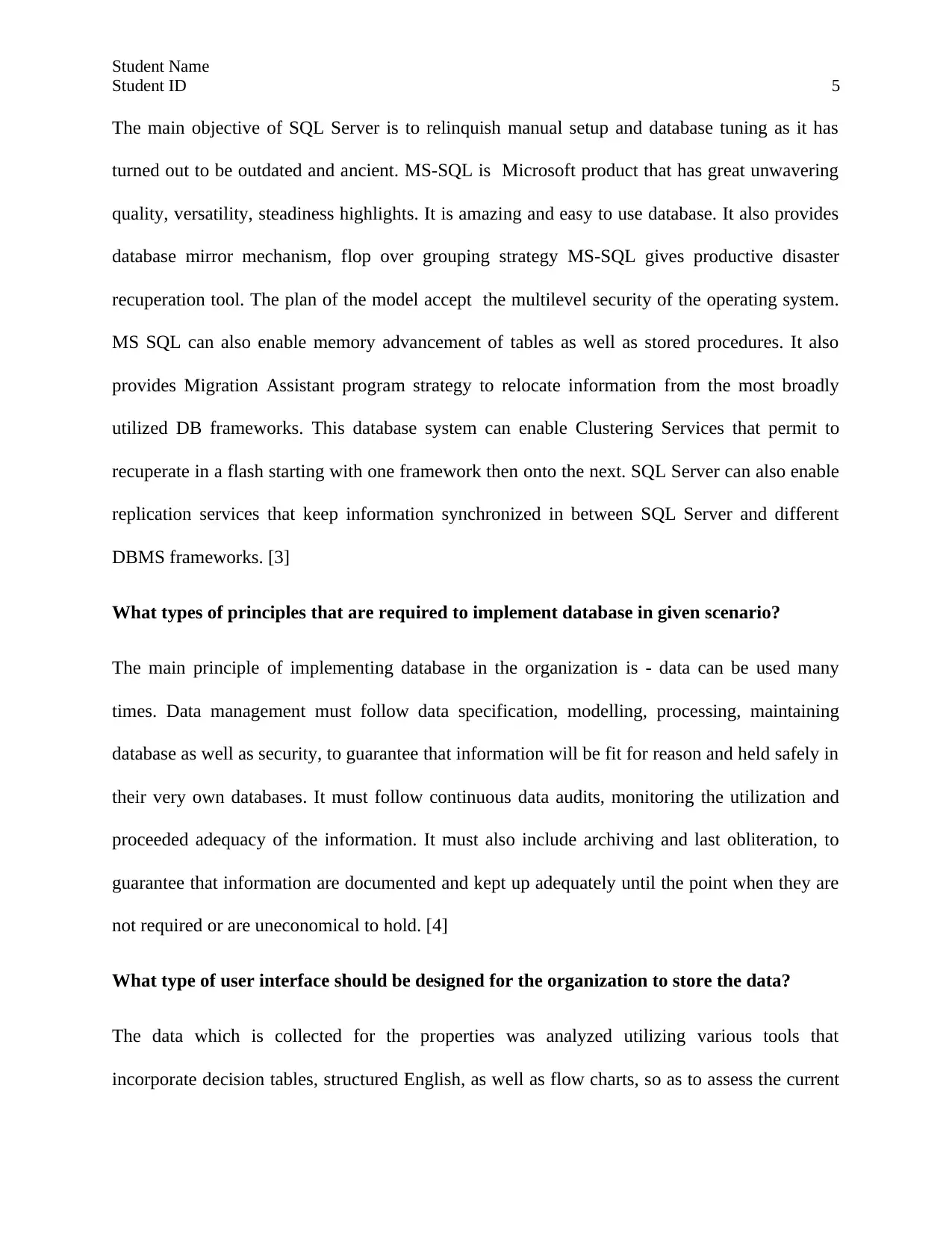
Student Name
Student ID 5
The main objective of SQL Server is to relinquish manual setup and database tuning as it has
turned out to be outdated and ancient. MS-SQL is Microsoft product that has great unwavering
quality, versatility, steadiness highlights. It is amazing and easy to use database. It also provides
database mirror mechanism, flop over grouping strategy MS-SQL gives productive disaster
recuperation tool. The plan of the model accept the multilevel security of the operating system.
MS SQL can also enable memory advancement of tables as well as stored procedures. It also
provides Migration Assistant program strategy to relocate information from the most broadly
utilized DB frameworks. This database system can enable Clustering Services that permit to
recuperate in a flash starting with one framework then onto the next. SQL Server can also enable
replication services that keep information synchronized in between SQL Server and different
DBMS frameworks. [3]
What types of principles that are required to implement database in given scenario?
The main principle of implementing database in the organization is - data can be used many
times. Data management must follow data specification, modelling, processing, maintaining
database as well as security, to guarantee that information will be fit for reason and held safely in
their very own databases. It must follow continuous data audits, monitoring the utilization and
proceeded adequacy of the information. It must also include archiving and last obliteration, to
guarantee that information are documented and kept up adequately until the point when they are
not required or are uneconomical to hold. [4]
What type of user interface should be designed for the organization to store the data?
The data which is collected for the properties was analyzed utilizing various tools that
incorporate decision tables, structured English, as well as flow charts, so as to assess the current
Student ID 5
The main objective of SQL Server is to relinquish manual setup and database tuning as it has
turned out to be outdated and ancient. MS-SQL is Microsoft product that has great unwavering
quality, versatility, steadiness highlights. It is amazing and easy to use database. It also provides
database mirror mechanism, flop over grouping strategy MS-SQL gives productive disaster
recuperation tool. The plan of the model accept the multilevel security of the operating system.
MS SQL can also enable memory advancement of tables as well as stored procedures. It also
provides Migration Assistant program strategy to relocate information from the most broadly
utilized DB frameworks. This database system can enable Clustering Services that permit to
recuperate in a flash starting with one framework then onto the next. SQL Server can also enable
replication services that keep information synchronized in between SQL Server and different
DBMS frameworks. [3]
What types of principles that are required to implement database in given scenario?
The main principle of implementing database in the organization is - data can be used many
times. Data management must follow data specification, modelling, processing, maintaining
database as well as security, to guarantee that information will be fit for reason and held safely in
their very own databases. It must follow continuous data audits, monitoring the utilization and
proceeded adequacy of the information. It must also include archiving and last obliteration, to
guarantee that information are documented and kept up adequately until the point when they are
not required or are uneconomical to hold. [4]
What type of user interface should be designed for the organization to store the data?
The data which is collected for the properties was analyzed utilizing various tools that
incorporate decision tables, structured English, as well as flow charts, so as to assess the current
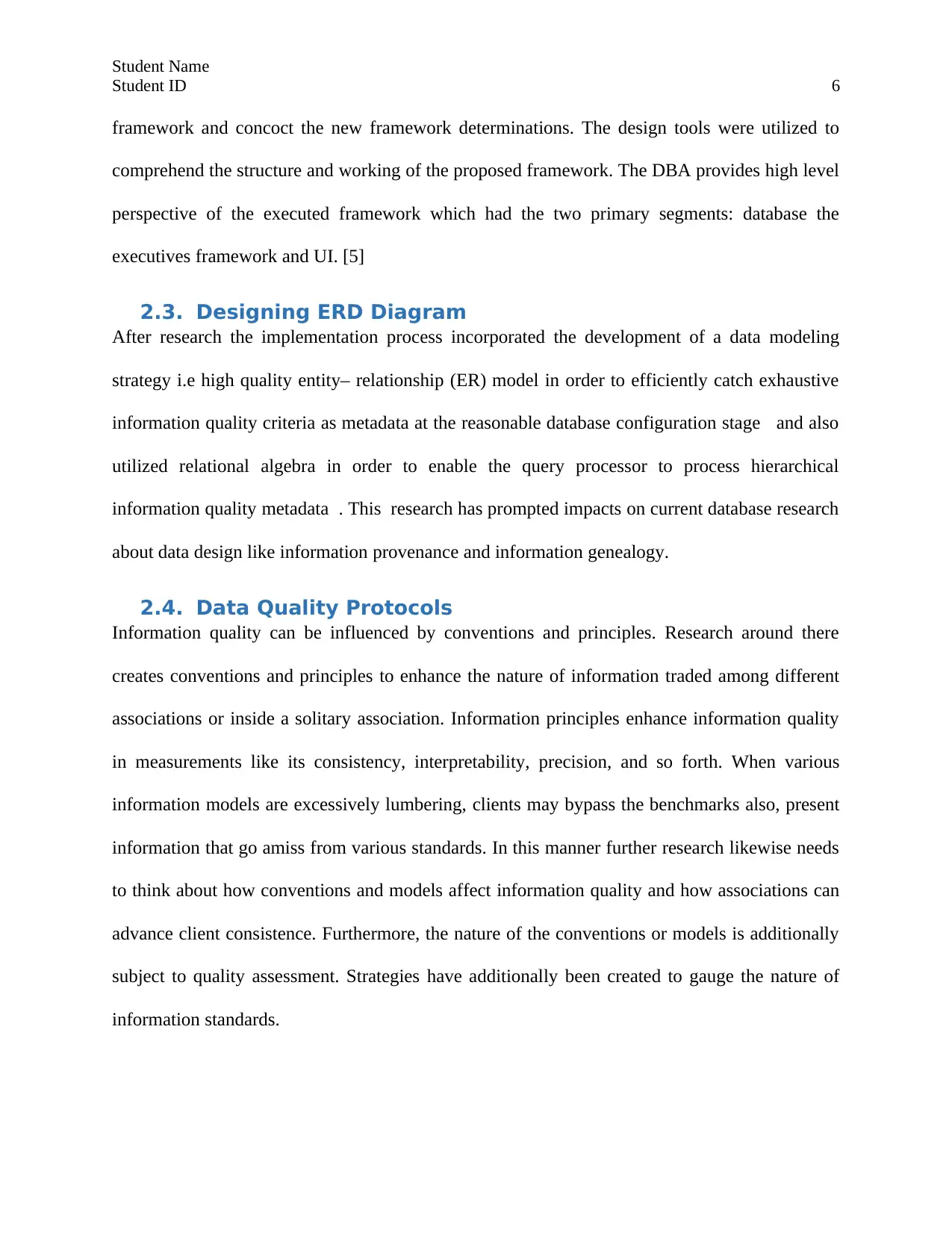
Student Name
Student ID 6
framework and concoct the new framework determinations. The design tools were utilized to
comprehend the structure and working of the proposed framework. The DBA provides high level
perspective of the executed framework which had the two primary segments: database the
executives framework and UI. [5]
2.3. Designing ERD Diagram
After research the implementation process incorporated the development of a data modeling
strategy i.e high quality entity– relationship (ER) model in order to efficiently catch exhaustive
information quality criteria as metadata at the reasonable database configuration stage and also
utilized relational algebra in order to enable the query processor to process hierarchical
information quality metadata . This research has prompted impacts on current database research
about data design like information provenance and information genealogy.
2.4. Data Quality Protocols
Information quality can be influenced by conventions and principles. Research around there
creates conventions and principles to enhance the nature of information traded among different
associations or inside a solitary association. Information principles enhance information quality
in measurements like its consistency, interpretability, precision, and so forth. When various
information models are excessively lumbering, clients may bypass the benchmarks also, present
information that go amiss from various standards. In this manner further research likewise needs
to think about how conventions and models affect information quality and how associations can
advance client consistence. Furthermore, the nature of the conventions or models is additionally
subject to quality assessment. Strategies have additionally been created to gauge the nature of
information standards.
Student ID 6
framework and concoct the new framework determinations. The design tools were utilized to
comprehend the structure and working of the proposed framework. The DBA provides high level
perspective of the executed framework which had the two primary segments: database the
executives framework and UI. [5]
2.3. Designing ERD Diagram
After research the implementation process incorporated the development of a data modeling
strategy i.e high quality entity– relationship (ER) model in order to efficiently catch exhaustive
information quality criteria as metadata at the reasonable database configuration stage and also
utilized relational algebra in order to enable the query processor to process hierarchical
information quality metadata . This research has prompted impacts on current database research
about data design like information provenance and information genealogy.
2.4. Data Quality Protocols
Information quality can be influenced by conventions and principles. Research around there
creates conventions and principles to enhance the nature of information traded among different
associations or inside a solitary association. Information principles enhance information quality
in measurements like its consistency, interpretability, precision, and so forth. When various
information models are excessively lumbering, clients may bypass the benchmarks also, present
information that go amiss from various standards. In this manner further research likewise needs
to think about how conventions and models affect information quality and how associations can
advance client consistence. Furthermore, the nature of the conventions or models is additionally
subject to quality assessment. Strategies have additionally been created to gauge the nature of
information standards.
⊘ This is a preview!⊘
Do you want full access?
Subscribe today to unlock all pages.

Trusted by 1+ million students worldwide
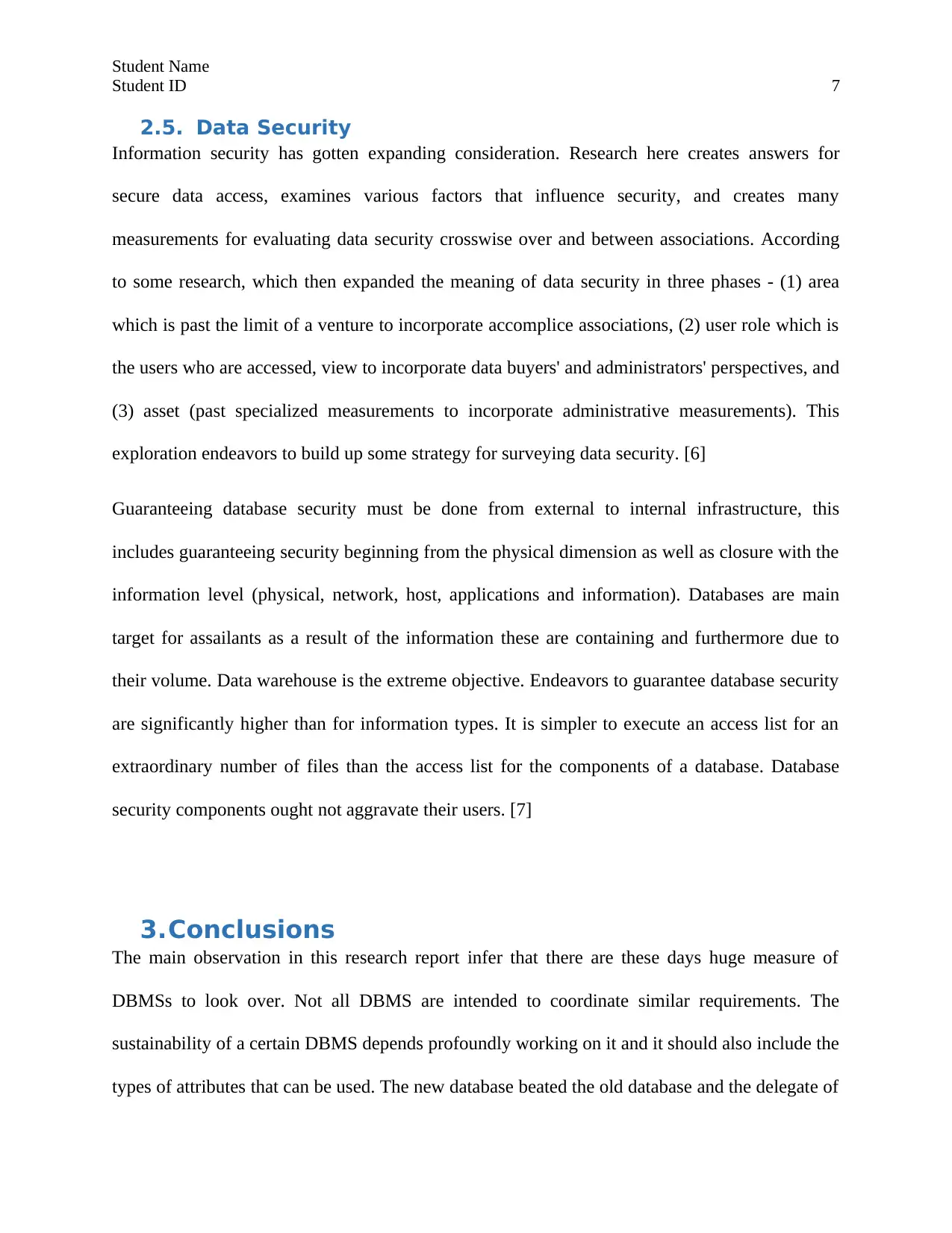
Student Name
Student ID 7
2.5. Data Security
Information security has gotten expanding consideration. Research here creates answers for
secure data access, examines various factors that influence security, and creates many
measurements for evaluating data security crosswise over and between associations. According
to some research, which then expanded the meaning of data security in three phases - (1) area
which is past the limit of a venture to incorporate accomplice associations, (2) user role which is
the users who are accessed, view to incorporate data buyers' and administrators' perspectives, and
(3) asset (past specialized measurements to incorporate administrative measurements). This
exploration endeavors to build up some strategy for surveying data security. [6]
Guaranteeing database security must be done from external to internal infrastructure, this
includes guaranteeing security beginning from the physical dimension as well as closure with the
information level (physical, network, host, applications and information). Databases are main
target for assailants as a result of the information these are containing and furthermore due to
their volume. Data warehouse is the extreme objective. Endeavors to guarantee database security
are significantly higher than for information types. It is simpler to execute an access list for an
extraordinary number of files than the access list for the components of a database. Database
security components ought not aggravate their users. [7]
3.Conclusions
The main observation in this research report infer that there are these days huge measure of
DBMSs to look over. Not all DBMS are intended to coordinate similar requirements. The
sustainability of a certain DBMS depends profoundly working on it and it should also include the
types of attributes that can be used. The new database beated the old database and the delegate of
Student ID 7
2.5. Data Security
Information security has gotten expanding consideration. Research here creates answers for
secure data access, examines various factors that influence security, and creates many
measurements for evaluating data security crosswise over and between associations. According
to some research, which then expanded the meaning of data security in three phases - (1) area
which is past the limit of a venture to incorporate accomplice associations, (2) user role which is
the users who are accessed, view to incorporate data buyers' and administrators' perspectives, and
(3) asset (past specialized measurements to incorporate administrative measurements). This
exploration endeavors to build up some strategy for surveying data security. [6]
Guaranteeing database security must be done from external to internal infrastructure, this
includes guaranteeing security beginning from the physical dimension as well as closure with the
information level (physical, network, host, applications and information). Databases are main
target for assailants as a result of the information these are containing and furthermore due to
their volume. Data warehouse is the extreme objective. Endeavors to guarantee database security
are significantly higher than for information types. It is simpler to execute an access list for an
extraordinary number of files than the access list for the components of a database. Database
security components ought not aggravate their users. [7]
3.Conclusions
The main observation in this research report infer that there are these days huge measure of
DBMSs to look over. Not all DBMS are intended to coordinate similar requirements. The
sustainability of a certain DBMS depends profoundly working on it and it should also include the
types of attributes that can be used. The new database beated the old database and the delegate of
Paraphrase This Document
Need a fresh take? Get an instant paraphrase of this document with our AI Paraphraser
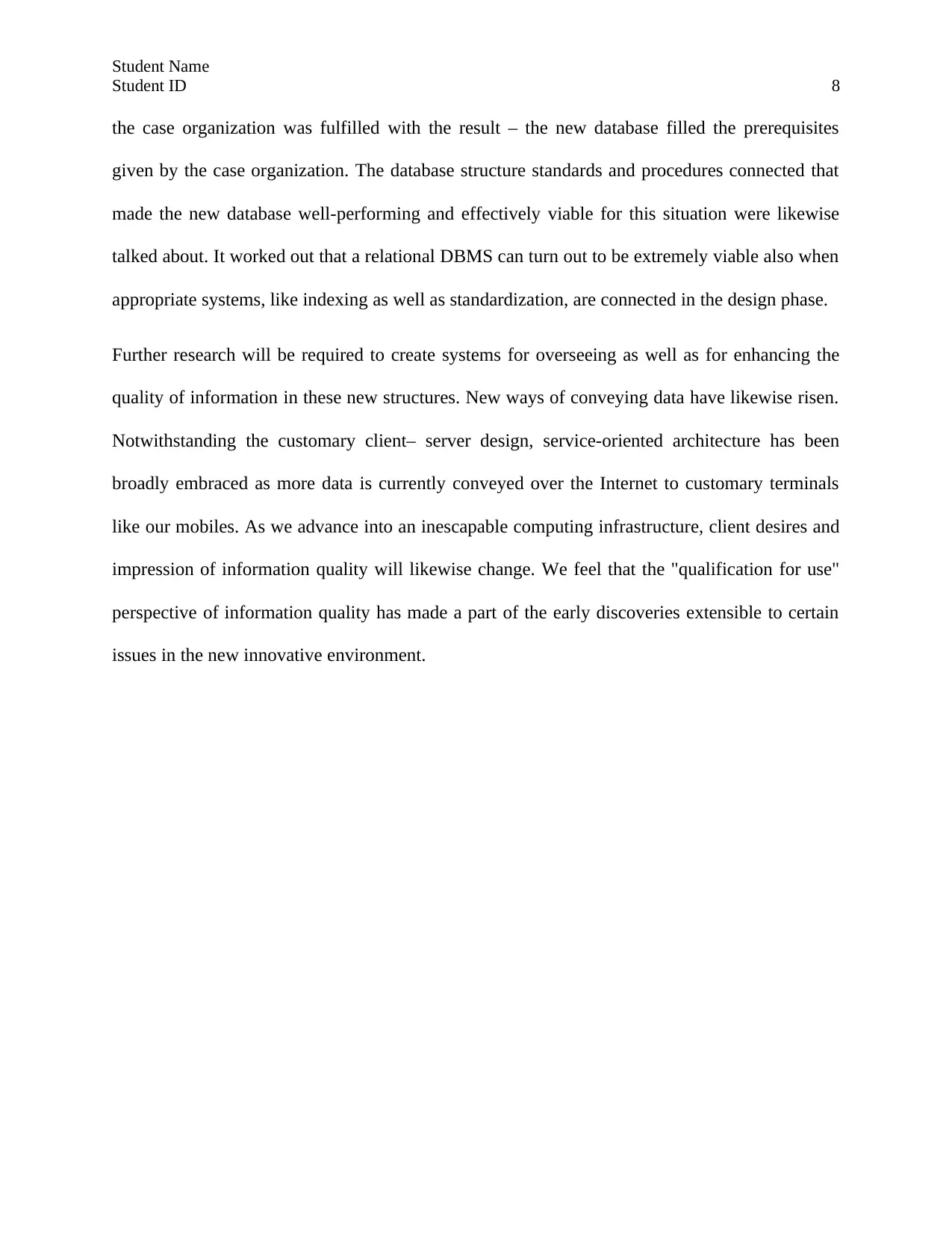
Student Name
Student ID 8
the case organization was fulfilled with the result – the new database filled the prerequisites
given by the case organization. The database structure standards and procedures connected that
made the new database well-performing and effectively viable for this situation were likewise
talked about. It worked out that a relational DBMS can turn out to be extremely viable also when
appropriate systems, like indexing as well as standardization, are connected in the design phase.
Further research will be required to create systems for overseeing as well as for enhancing the
quality of information in these new structures. New ways of conveying data have likewise risen.
Notwithstanding the customary client– server design, service-oriented architecture has been
broadly embraced as more data is currently conveyed over the Internet to customary terminals
like our mobiles. As we advance into an inescapable computing infrastructure, client desires and
impression of information quality will likewise change. We feel that the "qualification for use"
perspective of information quality has made a part of the early discoveries extensible to certain
issues in the new innovative environment.
Student ID 8
the case organization was fulfilled with the result – the new database filled the prerequisites
given by the case organization. The database structure standards and procedures connected that
made the new database well-performing and effectively viable for this situation were likewise
talked about. It worked out that a relational DBMS can turn out to be extremely viable also when
appropriate systems, like indexing as well as standardization, are connected in the design phase.
Further research will be required to create systems for overseeing as well as for enhancing the
quality of information in these new structures. New ways of conveying data have likewise risen.
Notwithstanding the customary client– server design, service-oriented architecture has been
broadly embraced as more data is currently conveyed over the Internet to customary terminals
like our mobiles. As we advance into an inescapable computing infrastructure, client desires and
impression of information quality will likewise change. We feel that the "qualification for use"
perspective of information quality has made a part of the early discoveries extensible to certain
issues in the new innovative environment.
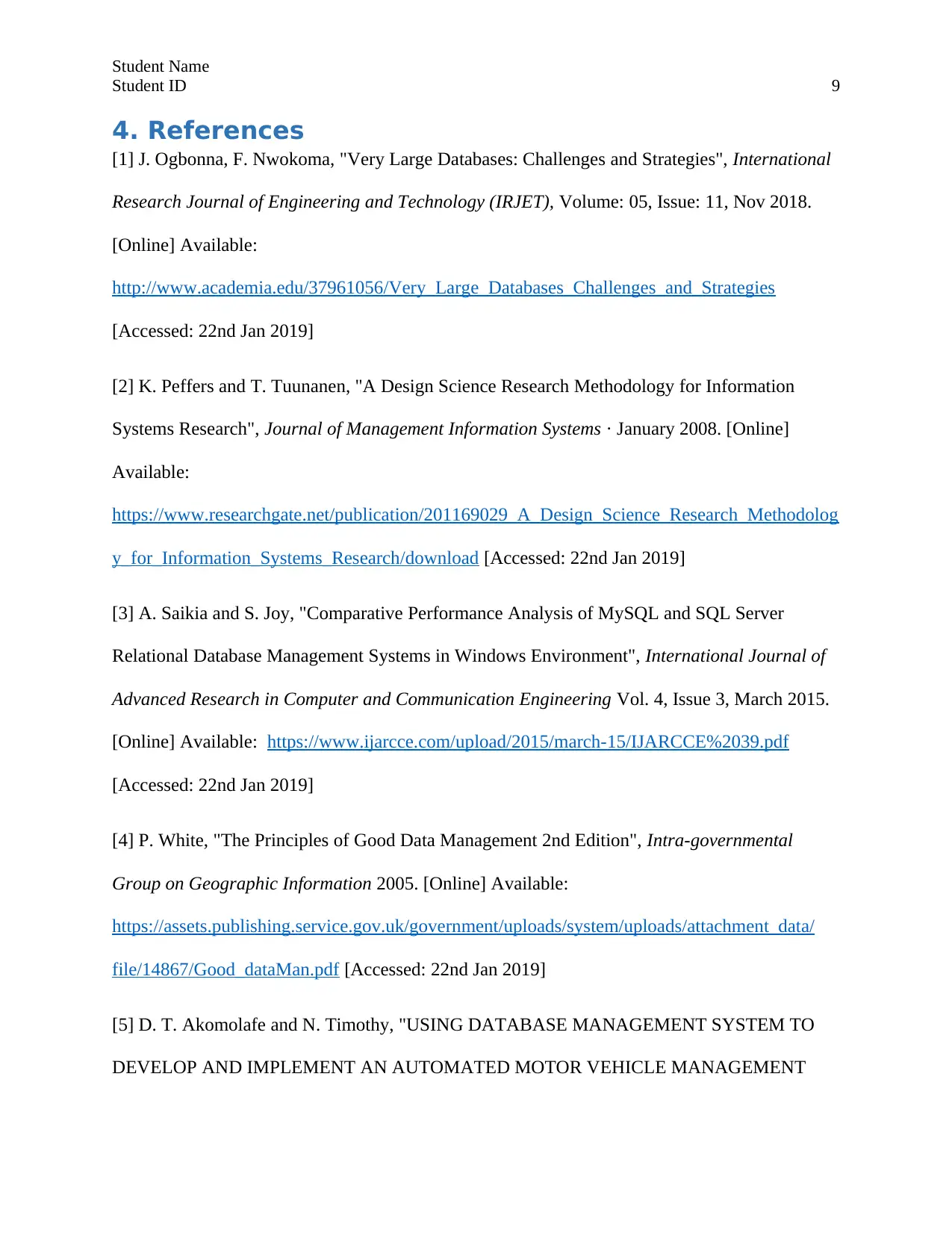
Student Name
Student ID 9
4. References
[1] J. Ogbonna, F. Nwokoma, "Very Large Databases: Challenges and Strategies", International
Research Journal of Engineering and Technology (IRJET), Volume: 05, Issue: 11, Nov 2018.
[Online] Available:
http://www.academia.edu/37961056/Very_Large_Databases_Challenges_and_Strategies
[Accessed: 22nd Jan 2019]
[2] K. Peffers and T. Tuunanen, "A Design Science Research Methodology for Information
Systems Research", Journal of Management Information Systems · January 2008. [Online]
Available:
https://www.researchgate.net/publication/201169029_A_Design_Science_Research_Methodolog
y_for_Information_Systems_Research/download [Accessed: 22nd Jan 2019]
[3] A. Saikia and S. Joy, "Comparative Performance Analysis of MySQL and SQL Server
Relational Database Management Systems in Windows Environment", International Journal of
Advanced Research in Computer and Communication Engineering Vol. 4, Issue 3, March 2015.
[Online] Available: https://www.ijarcce.com/upload/2015/march-15/IJARCCE%2039.pdf
[Accessed: 22nd Jan 2019]
[4] P. White, "The Principles of Good Data Management 2nd Edition", Intra-governmental
Group on Geographic Information 2005. [Online] Available:
https://assets.publishing.service.gov.uk/government/uploads/system/uploads/attachment_data/
file/14867/Good_dataMan.pdf [Accessed: 22nd Jan 2019]
[5] D. T. Akomolafe and N. Timothy, "USING DATABASE MANAGEMENT SYSTEM TO
DEVELOP AND IMPLEMENT AN AUTOMATED MOTOR VEHICLE MANAGEMENT
Student ID 9
4. References
[1] J. Ogbonna, F. Nwokoma, "Very Large Databases: Challenges and Strategies", International
Research Journal of Engineering and Technology (IRJET), Volume: 05, Issue: 11, Nov 2018.
[Online] Available:
http://www.academia.edu/37961056/Very_Large_Databases_Challenges_and_Strategies
[Accessed: 22nd Jan 2019]
[2] K. Peffers and T. Tuunanen, "A Design Science Research Methodology for Information
Systems Research", Journal of Management Information Systems · January 2008. [Online]
Available:
https://www.researchgate.net/publication/201169029_A_Design_Science_Research_Methodolog
y_for_Information_Systems_Research/download [Accessed: 22nd Jan 2019]
[3] A. Saikia and S. Joy, "Comparative Performance Analysis of MySQL and SQL Server
Relational Database Management Systems in Windows Environment", International Journal of
Advanced Research in Computer and Communication Engineering Vol. 4, Issue 3, March 2015.
[Online] Available: https://www.ijarcce.com/upload/2015/march-15/IJARCCE%2039.pdf
[Accessed: 22nd Jan 2019]
[4] P. White, "The Principles of Good Data Management 2nd Edition", Intra-governmental
Group on Geographic Information 2005. [Online] Available:
https://assets.publishing.service.gov.uk/government/uploads/system/uploads/attachment_data/
file/14867/Good_dataMan.pdf [Accessed: 22nd Jan 2019]
[5] D. T. Akomolafe and N. Timothy, "USING DATABASE MANAGEMENT SYSTEM TO
DEVELOP AND IMPLEMENT AN AUTOMATED MOTOR VEHICLE MANAGEMENT
⊘ This is a preview!⊘
Do you want full access?
Subscribe today to unlock all pages.

Trusted by 1+ million students worldwide
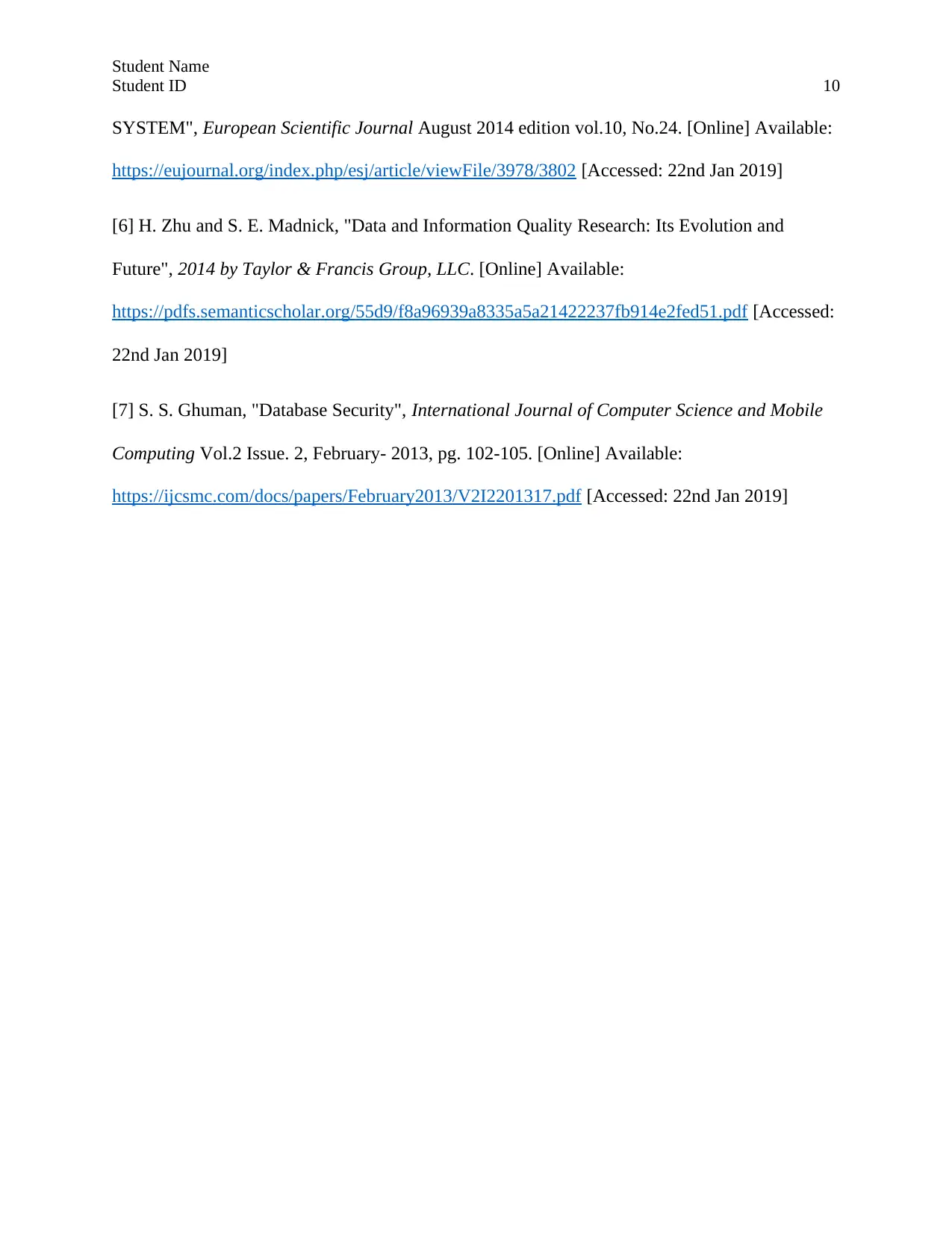
Student Name
Student ID 10
SYSTEM", European Scientific Journal August 2014 edition vol.10, No.24. [Online] Available:
https://eujournal.org/index.php/esj/article/viewFile/3978/3802 [Accessed: 22nd Jan 2019]
[6] H. Zhu and S. E. Madnick, "Data and Information Quality Research: Its Evolution and
Future", 2014 by Taylor & Francis Group, LLC. [Online] Available:
https://pdfs.semanticscholar.org/55d9/f8a96939a8335a5a21422237fb914e2fed51.pdf [Accessed:
22nd Jan 2019]
[7] S. S. Ghuman, "Database Security", International Journal of Computer Science and Mobile
Computing Vol.2 Issue. 2, February- 2013, pg. 102-105. [Online] Available:
https://ijcsmc.com/docs/papers/February2013/V2I2201317.pdf [Accessed: 22nd Jan 2019]
Student ID 10
SYSTEM", European Scientific Journal August 2014 edition vol.10, No.24. [Online] Available:
https://eujournal.org/index.php/esj/article/viewFile/3978/3802 [Accessed: 22nd Jan 2019]
[6] H. Zhu and S. E. Madnick, "Data and Information Quality Research: Its Evolution and
Future", 2014 by Taylor & Francis Group, LLC. [Online] Available:
https://pdfs.semanticscholar.org/55d9/f8a96939a8335a5a21422237fb914e2fed51.pdf [Accessed:
22nd Jan 2019]
[7] S. S. Ghuman, "Database Security", International Journal of Computer Science and Mobile
Computing Vol.2 Issue. 2, February- 2013, pg. 102-105. [Online] Available:
https://ijcsmc.com/docs/papers/February2013/V2I2201317.pdf [Accessed: 22nd Jan 2019]
1 out of 10
Related Documents
Your All-in-One AI-Powered Toolkit for Academic Success.
+13062052269
info@desklib.com
Available 24*7 on WhatsApp / Email
![[object Object]](/_next/static/media/star-bottom.7253800d.svg)
Unlock your academic potential
Copyright © 2020–2025 A2Z Services. All Rights Reserved. Developed and managed by ZUCOL.





